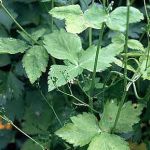| Common Name: |
Japanese Honewort |
| Other Names: |
Japanese wild chervil/parsley, mitsuba |
| Botanical Name: |
Cryptotaenia japonica |
| Genus: |
Cryptotaenia |
| Family: |
Apiaceae |
| Native Location: |
Temperate Asia, mainly China, Japan, Korea, Taiwan |
| Cultivation: |
Rich moist soil in shade or partial shade. May be grown as an annual or perennial for culinary use. Plants from spring sowings may be blanched in winter/early spring by mounding with soil or covering with straw. |
| Propagation: |
By seed sown successfully, from early spring to mid-summer; by division in spring or autumn. |
| Harvest: |
Seedlings and young leaves are cut as required and used fresh. Roots are harvested when young. Seed heads are collected when almost ripe and hung upside down to dry. |
| Variation: |
F. atropurpurea
Has deep purple foliage.
Kansai
Is a popular variety for annual cultivation of 'green' mitsuba
Kanto
Has pale stalks, favored for blanching and perennial cultivation. |
| Height: |
30-90cm (1-3ft) |
| Width: |
30cm (1ft) |
| Hardiness: |
Z4-9 |
| Parts Used: |
Leaves, leaf stalks, roots, seeds. |
| Properties: |
An aromatic herb with an angelica-like flavor. |
| Culinary Uses: |
In Japanese cuisine, young leaves and leaf stalks are cooked as a green vegetable, often served cold with soy sauce. Green or blanched leaf stalks are added to soups, salads, tempura, savory custards, and dishes such as sukiyaki. Seedlings are eaten in salads, roots are cooked like parsnips and seeds are used as seasoning. |
| Bibliography: |
Encyclopedia of herbs by Deni Brown Copyright © 1995, 2001 Dorling Kindersley Limited. pg 184 |

